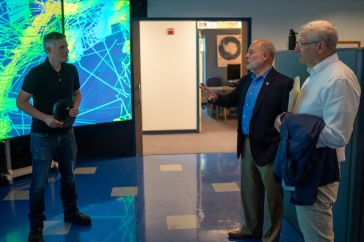
It sounds like a futuristic device out of a spy novel — a computer the size of a pinhead — but according to new UNH research it might be a reality sooner than once thought. Assistant professor of physics Jiadong Zang and his postdoctoral researcher Jie-Xiang Yu have discovered that an easily made combination of materials might offer a more stable environment for smaller and safer data storage, ultimately leading to miniature computers.
“We’re really optimistic about the possibilities,” says Zang, who published the findings recently in the journal Science Advances. “There is a push in the computer industry toward smaller and more powerful storage, yet current combinations of materials can create volatile situations, where data can be lost once the device is turned off. Our research points to this new combination as a much safer option. We’re excited that our findings might have the potential to change the landscape of information technology.”
In their study, Zang and Yu outline their proposed combination, which would allow for a more stable perpendicular anisotropic energy (PMA), the key driving component in a computer’s RAM (random-access memory) or data storage. There is a provisional patent pending, which has been filed by UNHInnovation, which advocates for, manages and promotes UNH’s intellectual property.
In an era dependent on extremely large amounts of information, from laptops to phones, Zang says the demand for more efficient devices is enormous. Creating smaller processors and storage units is an important step, not only for size but for data safety.
“There is a huge movement to switch to magnetic random access memory (MRAM) for storage in computers because it is more stable,” Zang says. “Not only is data storage safer, but there is also less radiation emitted from the device. Our calculations and material combination open the door to possibilities for much smaller computers for everything from basic data storage to traveling on space missions. Imagine launching a rocket with a computer the size of a pinhead — it not only saves space but also a lot of fuel.”
This work was supported by the U.S. Department of Energy, Office of Science, Basic Energy Sciences, under award no. DE-SC0016424. For more information on licensing this patent-pending technology, contact unh.innovation@unh.edu.
-
Written By:
Robbin Ray ’82 | UNH Marketing | robbin.ray@unh.edu | 603-862-4864

















































